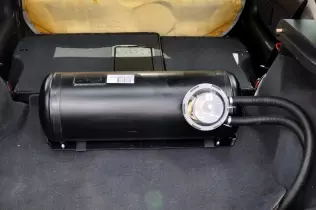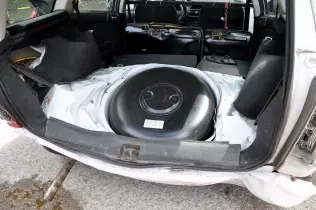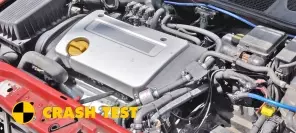- Main page
- Search
- Up to date
- Products
- Technology
- Vehicles
- Video
- Conversion Payback Simulator
Port Injection - Conversion Payback Simulator
Direct Injection - Conversion Payback Simulator
Diesel - Newsletter
When two autogas-powered cars collide...
 loading results...
loading results...However, during an accident involving an LPG-powered car, potential danger is not only in leakages (although there was virtually none here). Inertia of autogas system components may be an issue as well, particularly that of the tank, which is the heaviest.
The abrupt loss of speed during a crash (coming to a stop on a very short distance) generates considerable overload forces affecting the vehicle and all its parts. As a result, remarkable inertia forces are created and all sorts of fixings in the car must withstand them. This is also true for autogas system components, particularly tanks.
The red Astra (the hitting car) featured a cylindrical LPG tank. Its weight, including the multivalve and the fuel inside, was approx. 35 kg. In the case of collision with a solid obstacle, when the car comes to a stop within 1 metre, overload is approximately 20 g, so the aforementioned tank will pull its fixings as its weight were 700 kg. The 67 EEC UN regulation defines minimum overload values for LPG tank fixings at 20 g (for longitudinal impacts) based on real-life conditions.
The tank in the hitting car was fixed with four M12 bolts (8.8 durability class), providing appropriate rigidity of the fixing (20 g londitudinal and 8 g transverse overload resistance, as stated in the 67 regulation). After the impact, the tank remained in place and the fixing was as tight as before, which means it was done properly.
Tank fixing is particularly important in terms of autogas system safety, as – unlike automatically activated electrovalves and sensors – it requires attention and reliability from the installer. In fact, this is so important that we will devote a separate article to that theme.
The hit car (a white Opel Astra Caravan)
In the hit car, the risk of damage to the LPG tank (a toroidal one here) was particularly high – after all, it was fitted in the spare wheel well, near the end of the vehicle, within the crumple zone. Together with the fittings and fuel, the tank was over 40 kg in weight, which means overloads of 20 g could make the tank weigh 800 kg for a moment.
Despite considerable deformation of the car's rear, nothing happened to the tank. The spare wheel well moved upwards and to the front, but the tank itself wasn't dislodged and its high-pressure connections remained intact.
Autogas tanks are the heaviest, but also the most durable components of LPG systems – they aren't easily deformed in crashes. They have a broad durability margin, as required by the 67 regulation, to comply with which they are certified. This was clearly demonstrated in our crash test – the tank in the hit car was not deformed and proved rigid enough to provide extra protection to the rear, limiting the scale of damage. This extra stiffening caused moving the crumple zone towards the front of the car, but this wouldn't have caused any additional danger to the car's driver and passengers, should there be any onboard.
The tank fixing also proved proper. Two M12 bolts (8.8 durability class), properly tightened and featuring appropriate washers to prevent the tank from being pulled from the body, held the tank in place despite considerable deformation of the floor.
The connections of the LPG lines (the refueling one and the outlet of LPG towards the engine) as well as the multivalve were well protected by the tank's sturdy build. As is usual with toroidal tanks, the connections and the multivalve were located inside the torus, under the gas-tight cover of the multivalve.
All in all, the test proved that in extreme situations, with deformations and losses of tightness occuring, autogas systems create no additional danger to drivers and passengers of LPG-powered cars involved in crashes. Should the car be rear-ended or rear-end another vehicle, the autogas system's automatically activated safety measures cut off LPG flow to prevent leakages.








